Related Research Articles
Theobald of Bec was a Norman archbishop of Canterbury from 1139 to 1161. His exact birth date is unknown. Some time in the late 11th or early 12th century Theobald became a monk at the Abbey of Bec, rising to the position of abbot in 1137. King Stephen of England chose him to be Archbishop of Canterbury in 1138. Canterbury's claim to primacy over the Welsh ecclesiastics was resolved during Theobald's term of office when Pope Eugene III decided in 1148 in Canterbury's favour. Theobald faced challenges to his authority from a subordinate bishop, Henry of Blois, Bishop of Winchester and King Stephen's younger brother, and his relationship with King Stephen was turbulent. On one occasion Stephen forbade him from attending a papal council, but Theobald defied the king, which resulted in the confiscation of his property and temporary exile. Theobald's relations with his cathedral clergy and the monastic houses in his archdiocese were also difficult.
Aubrey de Vere — also known as "Alberic[us] de Ver" and "Albericus regis camerarius" — was the second of that name in England after the Norman Conquest, being the eldest surviving son of Aubrey de Vere and his wife Beatrice.
Robert of Melun was an English scholastic Christian theologian who taught in France, and later became Bishop of Hereford in England. He studied under Peter Abelard in Paris before teaching there and at Melun, which gave him his surname. His students included John of Salisbury, Roger of Worcester, William of Tyre, and possibly Thomas Becket. Robert was involved in the Council of Reims in 1148, which condemned the teachings of Gilbert de la Porrée. Three of his theological works survive, and show him to have been strictly orthodox.
The Bishop of Hereford is a character in the Robin Hood legend. He is typically portrayed as a wealthy and greedy clergyman who is robbed by Robin and his Merry Men.
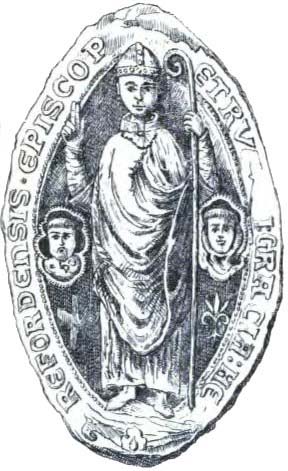
Peter of Aigueblanche was a medieval Bishop of Hereford. A nobleman from Savoy, he came to England as part of the party accompanying King Henry III's bride Eleanor of Provence. He entered the royal service, becoming bishop in 1241. He then served the king for a number of years as a diplomat, helping to arrange the marriage of Prince Edward. Peter became embroiled in King Henry's attempts to acquire the kingdom of Sicily, and Peter's efforts to raise money towards that goal brought condemnation from the clergy and barons of England. When the barons began to revolt against King Henry in the late 1250s and early 1260s, Peter was attacked and his lands and property pillaged. He was arrested briefly in 1263 by the barons, before being mostly restored to his lands after the Battle of Evesham.
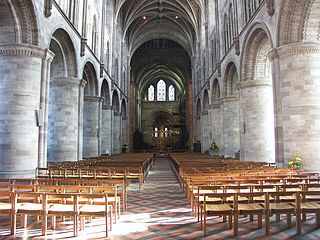
Gilbert Foliot was a medieval English monk and prelate, successively Abbot of Gloucester, Bishop of Hereford and Bishop of London. Born to an ecclesiastical family, he became a monk at Cluny Abbey in France at about the age of twenty. After holding two posts as prior in the Cluniac order he was appointed Abbot of Gloucester Abbey in 1139, a promotion influenced by his kinsman Miles of Gloucester. During his tenure as abbot he acquired additional land for the abbey, and may have helped to fabricate some charters—legal deeds attesting property ownership—to gain advantage in a dispute with the Archbishops of York. Although Foliot recognised Stephen as the King of England, he may have also sympathised with the Empress Matilda's claim to the throne. He joined Matilda's supporters after her forces captured Stephen, and continued to write letters in support of Matilda even after Stephen's release.
Agnes of Essex, Countess of Oxford was the daughter of a royal constable Henry of Essex and his second wife, Alice. At the age of three she was betrothed to Geoffrey de Vere, brother of the first Earl of Oxford, and turned over to be raised by the Veres soon thereafter. She remained in the household of the earl of Oxford about three years, then moved to Geoffrey's care. In her eleventh year Agnes rejected the match with Geoffrey and by early 1163 was married to his eldest brother Aubrey de Vere III, 1st Earl of Oxford, as his third wife.
Arnulf of Lisieux was a medieval French bishop who figured prominently as a conservative figure during the Renaissance of the 12th century, built the Cathedral of Lisieux, which introduced Gothic architecture to Normandy, and implemented the reforms of Bernard of Clairvaux.

Hilary was a medieval bishop of Chichester in England. English by birth, he studied canon law and worked in Rome as a papal clerk. During his time there, he became acquainted with a number of ecclesiastics, including the future Pope Adrian IV, and the writer John of Salisbury. In England, he served as a clerk for Henry of Blois, who was the bishop of Winchester and brother of King Stephen of England. After Hilary's unsuccessful nomination to become Archbishop of York, Pope Eugene III compensated him by promoting him to the bishopric of Chichester in 1147.
Richard Peche was a medieval Bishop of Lichfield.
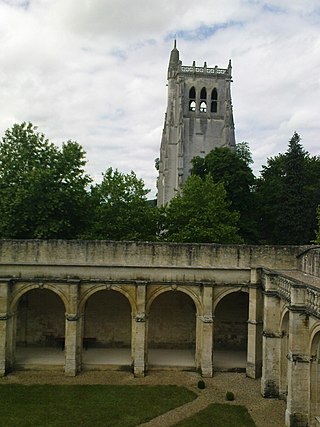
Hugh Nonant was a medieval Bishop of Coventry in England. A great-nephew and nephew of two Bishops of Lisieux, he held the office of archdeacon in that diocese before serving successively Thomas Becket, the Archbishop of Canterbury and King Henry II of England. Diplomatic successes earned him the nomination to Coventry, but diplomatic missions after his elevation led to a long delay before he was consecrated. After King Henry's death, Nonant served Henry's son, King Richard I, who rewarded him with the office of sheriff in three counties. Nonant replaced his monastic cathedral chapter with secular clergy, and attempted to persuade his fellow bishops to do the same, but was unsuccessful. When King Richard was captured and held for ransom, Nonant supported Prince John's efforts to seize power in England, but had to purchase Richard's favour when the king returned.
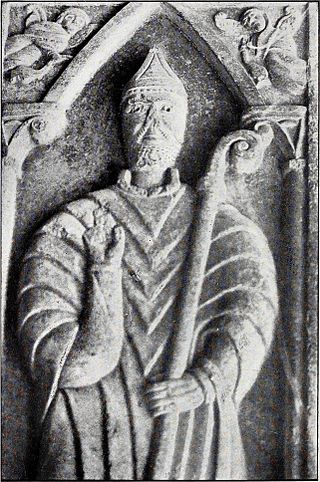
Bartholomew of Exeter was a medieval Bishop of Exeter. He came from Normandy and after being a clerk of the Archbishop of Canterbury, was made Archdeacon of Exeter in 1155. He became Bishop of Exeter in 1161. Known for his knowledge of canon law, he was involved in the Becket controversy after the appointment of Thomas Becket as Archbishop of Canterbury. After Becket's death, although he was frequently at the royal court, he mainly attended to his diocese. A number of works by him survive, including sermons and treatises on law and theology.

Robert de Bethune was a medieval bishop of Hereford. From a knightly family, he became a teacher before becoming a canon by 1115. He was elected prior of Llanthony Priory in the middle 1120s, and was named bishop by King Henry I of England in 1130. As bishop, he was often appointed a judge by the papacy, and was known for the care he took of his diocese.
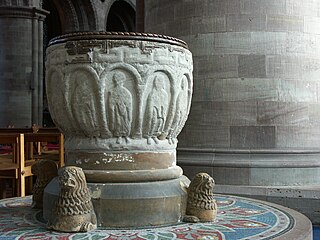
Robert Foliot was a medieval Bishop of Hereford in England. He was a relative of a number of English ecclesiastics, including Gilbert Foliot, one of his predecessors at Hereford. After serving Alexander, Bishop of Lincoln as a clerk, he became a clerk of Henry of Blois, the Bishop of Winchester and brother of King Stephen of England. He attended the Council of Reims in 1148, where another relative, Robert de Chesney, was elected as Bishop of Hereford. Chesney then secured the office of Archdeacon of Oxford for Foliot.
Robert de Chesney was a medieval English Bishop of Lincoln. He was the brother of an important royal official, William de Chesney, and the uncle of Gilbert Foliot, successively Bishop of Hereford and Bishop of London. Educated at Oxford or Paris, Chesney was Archdeacon of Leicester before his election as bishop in December 1148.
Richard de Belmeis I was a medieval cleric, administrator, judge and politician. Beginning as a minor landowner and steward in Shropshire, he became Henry I's chief agent in the Welsh Marches and in 1108 was appointed Bishop of London. He founded St Osyth's Priory in Essex and was succeeded by a considerable dynasty of clerical politicians and landowners.
Richard de Belmeis was a medieval cleric, administrator and politician. His career culminated in election as Bishop of London in 1152. He was one of the founders of Lilleshall Abbey in Shropshire.

Richard Barre was a medieval English justice, clergyman and scholar. He was educated at the law school of Bologna and entered royal service under King Henry II of England, later working for Henry's son and successor Richard I. He was also briefly in the household of Henry's son Henry the Young King. Barre served the elder Henry as a diplomat and was involved in a minor way with the king's quarrel with Thomas Becket, which earned Barre a condemnation from Becket. After King Henry's death, Barre became a royal justice during Richard's reign and was one of the main judges in the period from 1194 to 1199. After disagreeing with him earlier in his career, Barre was discharged from his judgeship during John's reign as king. Barre was also archdeacon of Ely and the author of a work of biblical extracts dedicated to one of his patrons, William Longchamp, the Bishop of Ely and Chancellor of England.

St Osyth's Abbey was a house of Augustinian canons in the parish of St Osyth in Essex, England in use from the 12th to 16th centuries. Founded by Richard de Belmeis, Bishop of London, c. 1121, it became one of the largest religious houses in Essex. It was dedicated to Saints Peter and Paul as well as St Osyth (Osith), a royal saint and virgin martyr. Bishop Richard obtained the arm bone of St Osyth from Aylesbury for the monastic church and granted the canons the parish church of St Osyth.
David FitzGerald was a medieval Bishop of St David's in Wales.
References
- Arnulf of Lisieux (1939). Barlow, Frank (ed.). The Letters of Arnulf of Lisieux. London: Offices of the Royal Historical Society. OCLC 789689.
- Barlow, Frank (1986). Thomas Becket . Berkeley, CA: University of California Press. ISBN 0-520-07175-1.
- Barrow, Julia (2000). "Athelstan to Aigueblanche, 1056–1268". In Aylmer, G.; Tiller, J. (eds.). Hereford Cathedral: A History. London: Hambledon Press. ISBN 978-1-85285-194-1.
- Barrow, Julia (2004). "Vere, William de (d. 1198)". Oxford Dictionary of National Biography (Oct 2007 revised ed.). Oxford University Press. doi:10.1093/ref:odnb/95042 . Retrieved 15 February 2009.(subscription or UK public library membership required)
- Blair, J. (1987). "Twelfth-century Bishop's Palace at Hereford". Medieval Archaeology. 31. doi:10.1080/00766097.1987.11735493.
- Cronne, H. A.; Davis, R. H. C.; Davis, H. W. C., eds. (1968). Regesta regum Anglo-Normannorum, 1066-1154: Regesta regis Stephani ac Mathildis imperatricia ac Gaufridi et Henrici Ducum Normannorum, 1135-1154. Vol. 3. Oxford, UK: Clarendon Press. OCLC 609731175.
- Fryde, E. B.; Greenway, D. E.; Porter, S.; Roy, I. (1996). Handbook of British Chronology (Third revised ed.). Cambridge, UK: Cambridge University Press. ISBN 0-521-56350-X.
- Saltman, Avrom (1956). Theobald: Archbishop of Canterbury . London: Athlone Press. OCLC 385687.